
Two films could sum up the american relationship with its society and its relationship with arms.
One is anti-American, its anti to all the values that we percieve as being "All American" apart from one.
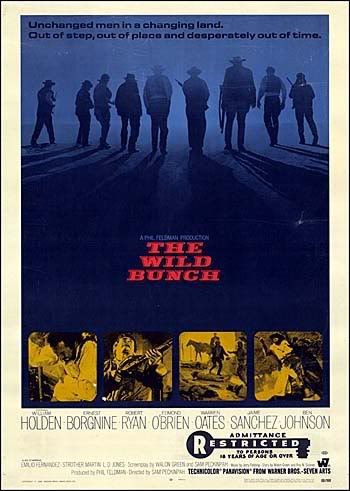
This is the relationship with money.The film The Wild Bunch bunch shares the idea that whoever one may be then there is always the possibility of striking it rich but even this is tempered by the fact of honour.
 The Second film "Winchester 76" is all American.The film is about a rifle and how that rifle is about true
The Second film "Winchester 76" is all American.The film is about a rifle and how that rifle is about true american values. Of course in a day and age where we now know that it was the american powers that killed Kennedy and that we may plausibly be aware that maybe the same thing happened in the Twin Towers destruction we can safely assume that these values are a figment of someones distorted imagination,maybe.

Making an assumption always freaks out the dumbos of this world but if we watched what we said because of dummy reaction there would be no progress even though with political

Presidential aspirant michelle bachmann is one dummy, it looks like we are taking a walk back into the middle ages.
The Wild Bunch doesn't care about the arms it uses but is solely interested in the fact that they work on the other hand the film Winchester 76 sees the arm as a hallowed religous

artifact.The film Winchester 73 begins with a typical American scene of American values.The best shooter.
Buy a gun in a shop kill all your friends at school then say you saw a film that made you do it, this is an American scenario not an Iranian one.

In a marksmanship contest, Lin McAdam wins a prized Winchester rifle, which is immediately stolen by the runner-up, D
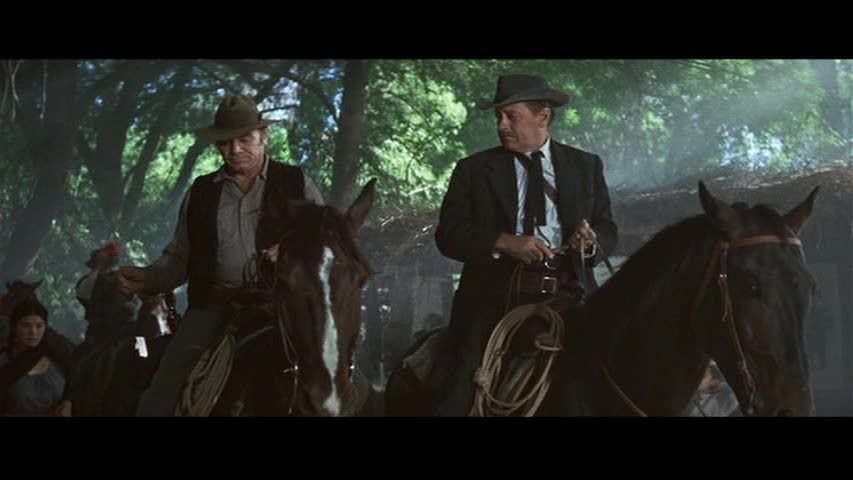
dutch Henry Brown. This "story of a rifle" then follows McAdams' pursuit, and the rifle as it
 changes hands, until a final showdown and shoot-out on a rocky mountain precipice.check out knights of avalon for the image
changes hands, until a final showdown and shoot-out on a rocky mountain precipice.check out knights of avalon for the image
here. its a great site.
Lin McAdam rides into town on the trail of Dutch Henry Brown, only to find himself in a shooting competition against him. McAdam wins the prize, a one-in-a-thousand Winchester rifle, but Dutch steals it and leaves town. McAdam follows, intent on settling his old quarrel, while the rifle keeps changing hands and touching a number of lives
intent on settling his old quarrel, while the rifle keeps changing hands and touching a number of lives
Lin McAdam rides into town on the trail of Dutch Henry Brown, only to find himself in a shooting competition against him. McAdam wins the prize, a one-in-a-thousand Winchester rifle, but Dutch steals it and leaves town. McAdam follows,
 intent on settling his old quarrel, while the rifle keeps changing hands and touching a number of lives
intent on settling his old quarrel, while the rifle keeps changing hands and touching a number of lives
The Winchester is the rifle most highly prized by Americans , it is in their eyes the gun that won the West but did it really. My own idea, and solely from what Ive read is that the gun that changed the way battles were fought was the Colt but who am I to say. Heres some other views.
Winchester usually means any of the lever-action rifles manufactured by the Winchester Repeating Arms Company, though the company has also manufactured many rifles of other action types. Winchester rifles were among the earliest repeating rifles; the Winchester repeater is colloquially known as "The Gun that Won the West" for its predominant role in the hands of Western settlers. in 1848 inventor Walter Hunt of New York patented his "Volition Repeating Rifle" incorporating a tubular magazine, which was operated by two levers and complex linkages.But what gun won the west?
in 1848 inventor Walter Hunt of New York patented his "Volition Repeating Rifle" incorporating a tubular magazine, which was operated by two levers and complex linkages.But what gun won the west?
Winchester usually means any of the lever-action rifles manufactured by the Winchester Repeating Arms Company, though the company has also manufactured many rifles of other action types. Winchester rifles were among the earliest repeating rifles; the Winchester repeater is colloquially known as "The Gun that Won the West" for its predominant role in the hands of Western settlers.

The Sharps rifle was popular among big game hunters, the military and target shooters towards the end of the 1800s. It had a reputation for being reliable, simple, powerful, robust and accurate. T There are numerous stories about the accuracy of the Sharps rifle. The best known individual shot is
There are numerous stories about the accuracy of the Sharps rifle. The best known individual shot is 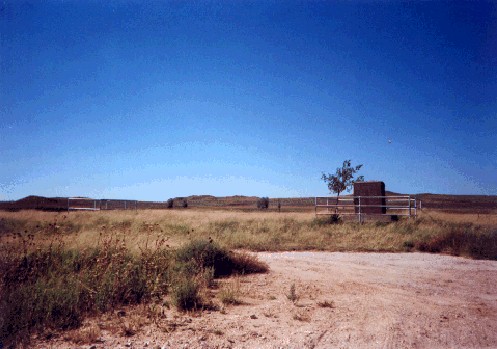
probably Billy Dixon's famous shot pointed against a group of Indians during the battle of Adobe Walls, Texas in 1874.
 There are numerous stories about the accuracy of the Sharps rifle. The best known individual shot is
There are numerous stories about the accuracy of the Sharps rifle. The best known individual shot is 
probably Billy Dixon's famous shot pointed against a group of Indians during the battle of Adobe Walls, Texas in 1874.

The actual distance between Dixon and the Indian has been debated. The numbers vary from 1538 yards (1406 metres) to 1028 yards (940 metres). The shot was probably fired from a .50 calibre rifle, most likely a .50-90 'Big Fifty'. Dixon later claimed that it was a lucky shot. 

The Indian was shot from his horse, but wasn't killed. The combined force of Comanche, Kiowa and Cheyenne Indians lifted the siege shortly after and retreated, but whether this was a direct consequence of Dixons shot is not known. However, it is known that the plains Indians had a deep respect for the buffalo hunters and their rifles.

Even though it was a lucky shot, the story about Billy Dixon indicates what a Sharps rifle was capable of in the hands of a skilled marksman.Was a Winchester capable of a shot like that?
Billy Dixon’s long shot, which ended the battle at adobe wells, is well documented, widely known and, undoubtedly, happened just as reported. 
Although some may argue the circumstances surrounding Mr. Dixon’s legendary shot, recent separate studies by Mr. Bill Falin and friends Harvey Watt and Paul Armbruster have demonstrated one thing, at least, to their satisfaction: Given calm shooting conditions and knowledge of the range involved, there is no doubt that Billy Dixon
least, to their satisfaction: Given calm shooting conditions and knowledge of the range involved, there is no doubt that Billy Dixon  could have toppled a mounted rider at 7/8 mile, or beyond. This is especially likely because, as Mr. Dixon explicitly states in his memoirs, he shot at a tightly huddled group of about 15 mounted horsemen.
could have toppled a mounted rider at 7/8 mile, or beyond. This is especially likely because, as Mr. Dixon explicitly states in his memoirs, he shot at a tightly huddled group of about 15 mounted horsemen.


Although some may argue the circumstances surrounding Mr. Dixon’s legendary shot, recent separate studies by Mr. Bill Falin and friends Harvey Watt and Paul Armbruster have demonstrated one thing, at
 least, to their satisfaction: Given calm shooting conditions and knowledge of the range involved, there is no doubt that Billy Dixon
least, to their satisfaction: Given calm shooting conditions and knowledge of the range involved, there is no doubt that Billy Dixon  could have toppled a mounted rider at 7/8 mile, or beyond. This is especially likely because, as Mr. Dixon explicitly states in his memoirs, he shot at a tightly huddled group of about 15 mounted horsemen.
could have toppled a mounted rider at 7/8 mile, or beyond. This is especially likely because, as Mr. Dixon explicitly states in his memoirs, he shot at a tightly huddled group of about 15 mounted horsemen.The Spencer repeating rifle was a manually operated lever-action, repeating riflefed from a tube magazine with cartridges. It was adopted by the Union Army, especially by the cavalry, during  the American Civil War, but did not replace the standard issue muzzle-loading rifled muskets in use at the time. The Spencer carbine was a shorter and lighter version.
the American Civil War, but did not replace the standard issue muzzle-loading rifled muskets in use at the time. The Spencer carbine was a shorter and lighter version. gentile
gentile
 the American Civil War, but did not replace the standard issue muzzle-loading rifled muskets in use at the time. The Spencer carbine was a shorter and lighter version.
the American Civil War, but did not replace the standard issue muzzle-loading rifled muskets in use at the time. The Spencer carbine was a shorter and lighter version. gentile
gentileThe design was completed by Christopher Spencer in 1860, and was for a magazine-fed, lever-operated rifle chambered for the 56-56 Spencer rimfire cartridge. Unlike later cartridge designations, the first  number referred to the diameter of the case at the head, while the second number referred to the diameter at the mouth; the actual bullet diameter was .52 inches. Cartridges were loaded with 45 grains (2.9 g) of black powder.
number referred to the diameter of the case at the head, while the second number referred to the diameter at the mouth; the actual bullet diameter was .52 inches. Cartridges were loaded with 45 grains (2.9 g) of black powder.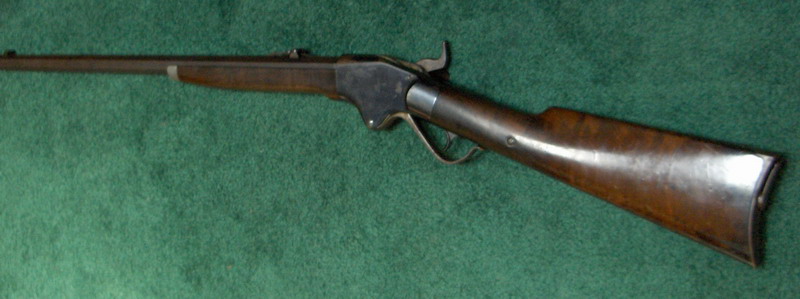
 number referred to the diameter of the case at the head, while the second number referred to the diameter at the mouth; the actual bullet diameter was .52 inches. Cartridges were loaded with 45 grains (2.9 g) of black powder.
number referred to the diameter of the case at the head, while the second number referred to the diameter at the mouth; the actual bullet diameter was .52 inches. Cartridges were loaded with 45 grains (2.9 g) of black powder.
To use the Spencer, a lever had to be worked to extract the used shell and feed a new cartridge from the tube. Like the Springfield Model 1873 Trapdoor Rifle, the hammer had to be manually cocked in a separate action. The weapon used rimfire cartridges stored in a seven-round tube magazine, enabling  the rounds to be fired one after another. When empty, the tube could be rapidly loaded either by dropping in fresh cartridges or from a device called the Blakeslee Cartridge Box, which contained up to thirteen (also six and ten) tubes with seven cartridges each, which could be emptied into the magazine tube in the buttstock.
the rounds to be fired one after another. When empty, the tube could be rapidly loaded either by dropping in fresh cartridges or from a device called the Blakeslee Cartridge Box, which contained up to thirteen (also six and ten) tubes with seven cartridges each, which could be emptied into the magazine tube in the buttstock.
 the rounds to be fired one after another. When empty, the tube could be rapidly loaded either by dropping in fresh cartridges or from a device called the Blakeslee Cartridge Box, which contained up to thirteen (also six and ten) tubes with seven cartridges each, which could be emptied into the magazine tube in the buttstock.
the rounds to be fired one after another. When empty, the tube could be rapidly loaded either by dropping in fresh cartridges or from a device called the Blakeslee Cartridge Box, which contained up to thirteen (also six and ten) tubes with seven cartridges each, which could be emptied into the magazine tube in the buttstock.
There were also 56–52, 56–50, and even a few 56–46 versions of the cartridge created, which were necked down versions of the original 56–56. Cartridge length was limited by the action size to about  1.75 inches, and the later calibers used a smaller diameter, lighter bullet and larger powder charge to (the crescent pieces here have no relation to the rifles used by the U.S cavalry)
1.75 inches, and the later calibers used a smaller diameter, lighter bullet and larger powder charge to (the crescent pieces here have no relation to the rifles used by the U.S cavalry)  increase the power and range over the original 56–56 cartridge, which, while about as powerful as the .58 caliber rifled musket of the time, was underpowered by the standards of other early cartridges such as the .50–70 and .45-70.
increase the power and range over the original 56–56 cartridge, which, while about as powerful as the .58 caliber rifled musket of the time, was underpowered by the standards of other early cartridges such as the .50–70 and .45-70.
 1.75 inches, and the later calibers used a smaller diameter, lighter bullet and larger powder charge to (the crescent pieces here have no relation to the rifles used by the U.S cavalry)
1.75 inches, and the later calibers used a smaller diameter, lighter bullet and larger powder charge to (the crescent pieces here have no relation to the rifles used by the U.S cavalry)  increase the power and range over the original 56–56 cartridge, which, while about as powerful as the .58 caliber rifled musket of the time, was underpowered by the standards of other early cartridges such as the .50–70 and .45-70.
increase the power and range over the original 56–56 cartridge, which, while about as powerful as the .58 caliber rifled musket of the time, was underpowered by the standards of other early cartridges such as the .50–70 and .45-70.At first, conservatism from the Department of War delayed its introduction to service. However, Christopher Spencer was eventually able to gain an audience with President Abraham Lincoln, who  subsequently invited him to a shooting match and demonstration of the weapon. Lincoln was impressed with the weapon, and ordered that it be adopted for production.
subsequently invited him to a shooting match and demonstration of the weapon. Lincoln was impressed with the weapon, and ordered that it be adopted for production.
 subsequently invited him to a shooting match and demonstration of the weapon. Lincoln was impressed with the weapon, and ordered that it be adopted for production.
subsequently invited him to a shooting match and demonstration of the weapon. Lincoln was impressed with the weapon, and ordered that it be adopted for production.
The Spencer repeating rifle was first adopted by the United States Navy, and subsequently adopted by the United States Army and used during the American Civil War where it was a popular weapon.
The man who killed Lincoln.
The South occasionally captured some of these weapons and ammunition, but, as they were unable to manufacture the cartridges because of shortages of copper, their ability to take advantage of the weapons was limited.(his Mummy)
manufacture the cartridges because of shortages of copper, their ability to take advantage of the weapons was limited.(his Mummy)
The Crescent mounties seem to have the winchester here above but thats just a guess
Notable early instances of use included the Battle of Hoover's Gap (where Col. John T. Wilder's "Lightning Brigade" effectively demonstrated the firepower of repeaters), and the Gettysburg Campaign, where two regiments of the Michigan Brigade (under Brig. Gen. George Armstrong Custer) carried them at the Battle of Hanover and at East Cavalry Field.As the war progressed, Spencers were carried by a number of Union cavalry and mounted infantry regiments and provided the Union army
two regiments of the Michigan Brigade (under Brig. Gen. George Armstrong Custer) carried them at the Battle of Hanover and at East Cavalry Field.As the war progressed, Spencers were carried by a number of Union cavalry and mounted infantry regiments and provided the Union army 
with additional firepower versus theirConfederate counterparts. President Lincoln's assassin, John Wilkes Booth the Southern patriot who killed lincoln was armed with a Spencer carbine at the time he was captured and killed.
Booth the Southern patriot who killed lincoln was armed with a Spencer carbine at the time he was captured and killed.

The man who killed Lincoln.
The South occasionally captured some of these weapons and ammunition, but, as they were unable to
 manufacture the cartridges because of shortages of copper, their ability to take advantage of the weapons was limited.(his Mummy)
manufacture the cartridges because of shortages of copper, their ability to take advantage of the weapons was limited.(his Mummy)
The Crescent mounties seem to have the winchester here above but thats just a guess
Notable early instances of use included the Battle of Hoover's Gap (where Col. John T. Wilder's "Lightning Brigade" effectively demonstrated the firepower of repeaters), and the Gettysburg Campaign, where
 two regiments of the Michigan Brigade (under Brig. Gen. George Armstrong Custer) carried them at the Battle of Hanover and at East Cavalry Field.As the war progressed, Spencers were carried by a number of Union cavalry and mounted infantry regiments and provided the Union army
two regiments of the Michigan Brigade (under Brig. Gen. George Armstrong Custer) carried them at the Battle of Hanover and at East Cavalry Field.As the war progressed, Spencers were carried by a number of Union cavalry and mounted infantry regiments and provided the Union army 
with additional firepower versus theirConfederate counterparts. President Lincoln's assassin, John Wilkes
The Spencer showed itself to be very reliable under combat conditions, with a sustainable rate-of-fire in excess of 20 rounds per minute. Compared to standard muzzle-loaders, with a rate of fire of 2-3 rounds per minute, this represented a significant tactical advantage. However, effective tactics had yet to be developed to take advantage of the higher rate of fire. Similarly, the supply chain was not equipped to carry the extra ammunition. Detractors would also complain that the smoke and haze produced was such that it was hard to see the enemy.
In the late 1860s, the Spencer company was sold to the Fogerty Rifle Company and ultimately to Winchester. With almost 200,000 rifles and carbines made, it marked the first adoption of a removable magazine-fed infantry rifle by any country. Many Spencer carbines were later sold as surplus to France where they were used during the Franco-Prussian War in 1870.

Despite the fact that the Spencer company went out of business in 1869, ammunition was sold in the United States up to about the 1920s. Later, many rifles and carbines were converted to centerfire, which could fire cartridges made from the centerfire .50–70 brass. Production ammunition can still be obtained on the specialty marke
The Hunt rifle fired what he called the "Rocket Ball," an early form of caseless ammunition in which the powder charge was contained in the bullet's hollow base. Hunt's design was fragile and unworkable; b_NRFPT_01.jpg) ut in 1849 Lewis Jennings purchased the Hunt patents and developed a functioning, if still complex, version which was produced in small numbers by Robbins & Lawrence of Windsor, Vermont until 1852.
ut in 1849 Lewis Jennings purchased the Hunt patents and developed a functioning, if still complex, version which was produced in small numbers by Robbins & Lawrence of Windsor, Vermont until 1852.
_NRFPT_01.jpg) ut in 1849 Lewis Jennings purchased the Hunt patents and developed a functioning, if still complex, version which was produced in small numbers by Robbins & Lawrence of Windsor, Vermont until 1852.
ut in 1849 Lewis Jennings purchased the Hunt patents and developed a functioning, if still complex, version which was produced in small numbers by Robbins & Lawrence of Windsor, Vermont until 1852. cylindrical copper case to hold the bullet and powder with the primer in the case rim, thus creating one of the most significant inventions in firearms history, the metallic rimfire cartridge.
cylindrical copper case to hold the bullet and powder with the primer in the case rim, thus creating one of the most significant inventions in firearms history, the metallic rimfire cartridge.
(Smith's cartridge, the .22 Short, would be introduced commercially in 1857 with the landmark Smith & Wesson Model 1 revolver and is still manufactured today.) Horace Smith and Daniel Wesson of Norwich, Connecticut acquired the Jennings patent from Robbins & Lawrence, as well as shop foremanBenjamin Tyler Henry.
Horace Smith and Daniel Wesson of Norwich, Connecticut acquired the Jennings patent from Robbins & Lawrence, as well as shop foremanBenjamin Tyler Henry. 
 Horace Smith and Daniel Wesson of Norwich, Connecticut acquired the Jennings patent from Robbins & Lawrence, as well as shop foremanBenjamin Tyler Henry.
Horace Smith and Daniel Wesson of Norwich, Connecticut acquired the Jennings patent from Robbins & Lawrence, as well as shop foremanBenjamin Tyler Henry. Smith made several improvements to the Jennings design, and in 1855 Smith and Wesson together with several investors formed a corporation, the Volcanic Repeating Arms Company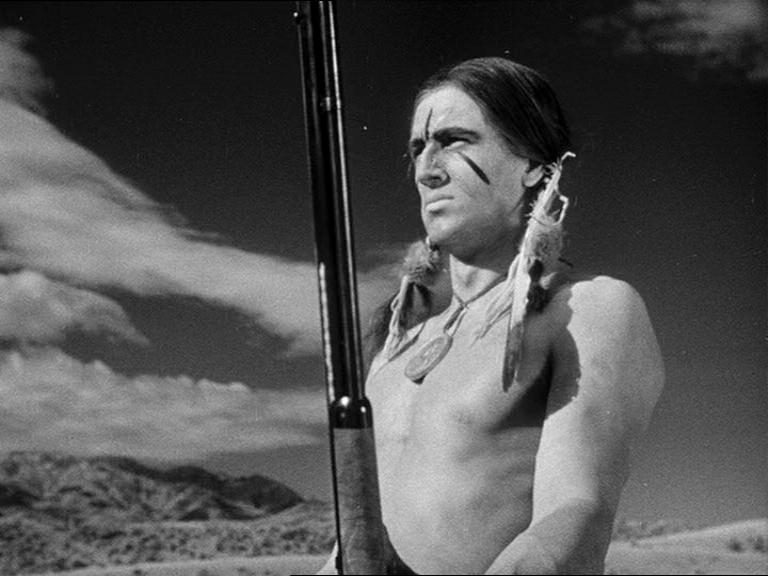 , to manufacture Smith's modification of the Hunt-Jennings, the Volcanic lever-action pistol and rifle. Its largest stockholder was Oliver Winchester.
, to manufacture Smith's modification of the Hunt-Jennings, the Volcanic lever-action pistol and rifle. Its largest stockholder was Oliver Winchester.
 , to manufacture Smith's modification of the Hunt-Jennings, the Volcanic lever-action pistol and rifle. Its largest stockholder was Oliver Winchester.
, to manufacture Smith's modification of the Hunt-Jennings, the Volcanic lever-action pistol and rifle. Its largest stockholder was Oliver Winchester.The Volcanic rifle had only limited success, which was in part attributable to the design and poor performance of the Hunt-derived Volcanic cartridge: a hollow conical ball filled with
poor performance of the Hunt-derived Volcanic cartridge: a hollow conical ball filled with  black powder and sealed by a cork primer.
black powder and sealed by a cork primer. 
Although the Volcanic's repeater design far outpaced the rival technology, the unsatisfactory power and reliability of the .25 and .32 caliber "Rocket Balls" were little match for the competitors' larger calibers. Wesson had left Volcanic soon after it was formed and Smith followed eight months later, to create the Smith & Wesson
Wesson had left Volcanic soon after it was formed and Smith followed eight months later, to create the Smith & Wesson
 poor performance of the Hunt-derived Volcanic cartridge: a hollow conical ball filled with
poor performance of the Hunt-derived Volcanic cartridge: a hollow conical ball filled with  black powder and sealed by a cork primer.
black powder and sealed by a cork primer. 
Although the Volcanic's repeater design far outpaced the rival technology, the unsatisfactory power and reliability of the .25 and .32 caliber "Rocket Balls" were little match for the competitors' larger calibers.
 Wesson had left Volcanic soon after it was formed and Smith followed eight months later, to create the Smith & Wesson
Wesson had left Volcanic soon after it was formed and Smith followed eight months later, to create the Smith & WessonRevolver Company.
Volcanic moved to New Haven in 1856, but by the end of that year became insolvent. Oliver Winchester purchased the bankrupt firm's assets from the remaining stockholders, and reorganized it as the New Haven Arms Company in April 18After the war, Oliver Winchester renamed New Haven Arms the Winchester Repeating Arms Company. The comp
reorganized it as the New Haven Arms Company in April 18After the war, Oliver Winchester renamed New Haven Arms the Winchester Repeating Arms Company. The comp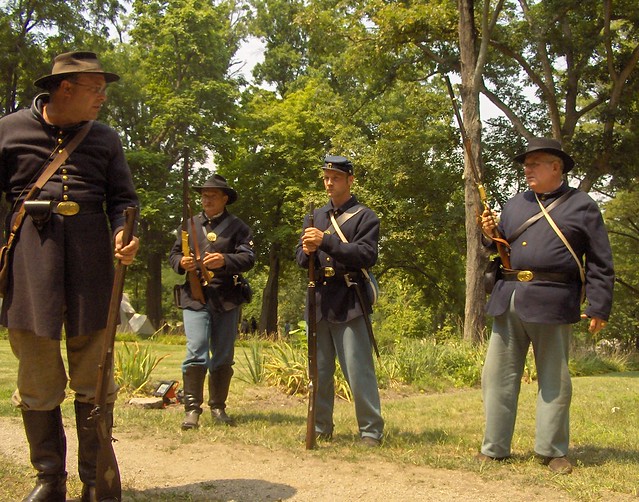 any modified and improved the basic design of the Henry rifle, creating the first Winchester rifle: the Model 1866. It retained the .44 Henry rimfire cartridge, was likewise built on a bronze-alloy frame, and had an improved magazine and a wooden forearm.If we conside
any modified and improved the basic design of the Henry rifle, creating the first Winchester rifle: the Model 1866. It retained the .44 Henry rimfire cartridge, was likewise built on a bronze-alloy frame, and had an improved magazine and a wooden forearm.If we conside  Holden and the Wild Bunch then we'd understand that if these fictional character were real then for sure they wouldnt be attending gun clubs, they are only interested in function whereas the James Stewert character would be a fully paid up member as Winchester is also about the status symbol of a gun.
Holden and the Wild Bunch then we'd understand that if these fictional character were real then for sure they wouldnt be attending gun clubs, they are only interested in function whereas the James Stewert character would be a fully paid up member as Winchester is also about the status symbol of a gun. In 1873 Winchester introduced the steel-framed Model 1873 chambering the more potent .44-40 centerfire cartridge. In 1876, in a bid to compete with the powerful single-shot rifles of the time, Winchester brought out the Model 1876 (Centennial Model).
In 1873 Winchester introduced the steel-framed Model 1873 chambering the more potent .44-40 centerfire cartridge. In 1876, in a bid to compete with the powerful single-shot rifles of the time, Winchester brought out the Model 1876 (Centennial Model). Benjamin Henry continued to work with Smith's cartridge concept, and perfected the much larger, more powerful .44 Henry rimfire. Henry also supervised the redesign of the rifle to use the new ammunition, retaining only the general form of the breech mechanism and the tubular magazine. This became the Henry rifle of 1860,
Benjamin Henry continued to work with Smith's cartridge concept, and perfected the much larger, more powerful .44 Henry rimfire. Henry also supervised the redesign of the rifle to use the new ammunition, retaining only the general form of the breech mechanism and the tubular magazine. This became the Henry rifle of 1860, which was manufactured by the New Haven Arms Company, and used in considerable numbers by certain Union army units in the American Civil War. Confederates called the Henry "that damned Yankee rifle that they load on Sunday and shoot all week.
which was manufactured by the New Haven Arms Company, and used in considerable numbers by certain Union army units in the American Civil War. Confederates called the Henry "that damned Yankee rifle that they load on Sunday and shoot all week.
 reorganized it as the New Haven Arms Company in April 18After the war, Oliver Winchester renamed New Haven Arms the Winchester Repeating Arms Company. The comp
reorganized it as the New Haven Arms Company in April 18After the war, Oliver Winchester renamed New Haven Arms the Winchester Repeating Arms Company. The comp any modified and improved the basic design of the Henry rifle, creating the first Winchester rifle: the Model 1866. It retained the .44 Henry rimfire cartridge, was likewise built on a bronze-alloy frame, and had an improved magazine and a wooden forearm.If we conside
any modified and improved the basic design of the Henry rifle, creating the first Winchester rifle: the Model 1866. It retained the .44 Henry rimfire cartridge, was likewise built on a bronze-alloy frame, and had an improved magazine and a wooden forearm.If we conside  Holden and the Wild Bunch then we'd understand that if these fictional character were real then for sure they wouldnt be attending gun clubs, they are only interested in function whereas the James Stewert character would be a fully paid up member as Winchester is also about the status symbol of a gun.
Holden and the Wild Bunch then we'd understand that if these fictional character were real then for sure they wouldnt be attending gun clubs, they are only interested in function whereas the James Stewert character would be a fully paid up member as Winchester is also about the status symbol of a gun. In 1873 Winchester introduced the steel-framed Model 1873 chambering the more potent .44-40 centerfire cartridge. In 1876, in a bid to compete with the powerful single-shot rifles of the time, Winchester brought out the Model 1876 (Centennial Model).
In 1873 Winchester introduced the steel-framed Model 1873 chambering the more potent .44-40 centerfire cartridge. In 1876, in a bid to compete with the powerful single-shot rifles of the time, Winchester brought out the Model 1876 (Centennial Model). Benjamin Henry continued to work with Smith's cartridge concept, and perfected the much larger, more powerful .44 Henry rimfire. Henry also supervised the redesign of the rifle to use the new ammunition, retaining only the general form of the breech mechanism and the tubular magazine. This became the Henry rifle of 1860,
Benjamin Henry continued to work with Smith's cartridge concept, and perfected the much larger, more powerful .44 Henry rimfire. Henry also supervised the redesign of the rifle to use the new ammunition, retaining only the general form of the breech mechanism and the tubular magazine. This became the Henry rifle of 1860, which was manufactured by the New Haven Arms Company, and used in considerable numbers by certain Union army units in the American Civil War. Confederates called the Henry "that damned Yankee rifle that they load on Sunday and shoot all week.
which was manufactured by the New Haven Arms Company, and used in considerable numbers by certain Union army units in the American Civil War. Confederates called the Henry "that damned Yankee rifle that they load on Sunday and shoot all week.From 1883, John Moses Browning worked in partnership with Winchester, designing a series of rifles and shotguns, most notably the lever-action Winchester Model 1886, Model 1892, Model 1894, and Model 1895 rifles, along with the lever-action Model 1887/1901 shotgun, the pump-action Model 1890 rifle, and the pump-action Model 1893/1897 shotgun. While it chambered more powerful cartridges than the 1866 and 1873 models, the toggle link action was not strong enough for the popular high-powered rounds used in Sharps or Remington single-shot rifles.
While it chambered more powerful cartridges than the 1866 and 1873 models, the toggle link action was not strong enough for the popular high-powered rounds used in Sharps or Remington single-shot rifles.
 While it chambered more powerful cartridges than the 1866 and 1873 models, the toggle link action was not strong enough for the popular high-powered rounds used in Sharps or Remington single-shot rifles.
While it chambered more powerful cartridges than the 1866 and 1873 models, the toggle link action was not strong enough for the popular high-powered rounds used in Sharps or Remington single-shot rifles.
The original Winchester rifle- the Winchester Model 1866- was famous for its rugged construction and lever-action mechanism that allowed the rifleman to fire a number of shots before having to reload: hence the term, "repeating rifle." Nelson King's new improved patent remedied flaws in the Henry rifle by incorporating a loading gate on the side of the frame and integrating a round sealed magazine which was covered by a fore stock. Originally chambered in the rimfire .44 Henry, the Model 1866 was nicknamed the "Yellow Boy" because of its "brass" receiver (actually a bronze alloy called gunmetal).

Winchester Model 1876
One of the most successful, and certainly one of the most famous Winchester rifles was certainly the Winchester Model 1873. Originally chambered for the .44-40 cartridge, it was later produced in .38-40 and .32-20, all of which were also popular handgun cartridges of the day. Due to feeding problems, the original Model 1873 was never offered in the military standard .45 Colt cartridge, although a number of modern reproductions of the rifle are chambered for the round. The popularity of the Winchester in .44-40 led Colt to manufacture a version of the Single Action Army"Peacemaker" revolver chambered for the same round; Winchester produced three variations of the Model 1873: the rifle, carbine, and musket (although the musket variation accounted for less than 5-10 percent of those produced). 
The rifle variation used a 24" barrel while the carbine used a 20" barrel. The carbine was the most popular due to its portability as well as allowing its users to conveniently carry one type of ammunition for both their rifles and pistols. Winchester produced over 720,000 carbines, making them hugely popular and readily available on the frontier. 
The pistol is the Sharps & Hankins breechloading pepperbox. Not really a revolver; its category is a little harder to define, but it was fired by a revolving striker. According to the information compiled by the National Firearms Museum, Sharps began producing these pepperboxes just as the Civil War began, and over a ten-year span produced 85,000 of them. He would go on to become much better known for the Sharps rifles heavily featured in the American West of the late 1800s.This popularity has led the Model 1873 to be credited as "The Gun that Won the West", although there are some that claim the Springfield Model 1873 deserves the title due to both the U.S. Army's and civilians' heavy usage of Springfields. Regardless, the legend inspired the 1950 Western film Winchester '73 starring Jimmy Stewart and directed by Anthony Mann.
The 1876 was introduced to celebrate the American Centennial, and earned a reputation as a durable and powerful hunting rifle. Originally chambered for the new .45-75 WCF cartridge (designed to replicate 
the .45-70 Gov't ballistics in a shorter case), versions in .40-60, .45-60 and .50-95 Express followed; the '76 in the latter chambering is the only repeater known to have been used in any numbers by the professional buffalo hunters.
The Canadian North-West Mounted Police used the '76 in .45-75 as a standard long arm for many years with 750 rifles purchased for the force in 1883; the Mountie-model '76 carbine was also issued to theTexas Rangers.

THE BIG HORN DEBACLE During the battle, the 7th Cavalry troopers were armed with the Springfield carbine Model 1873 and the Colt Single Action Army revolver Model 1873. Selection of the weapons was the result of much trial and error, plus official testing during 187173. The Ordnance Department staged field trials of 89 rifles and carbines, which included entries from Peabody, Spencer, Freeman, Elliot and Mauser. There were four primary contenders: the Ward-Burton bolt-action rifle; the Remington rolling-block; the 'trapdoor' Springfield; and the Sharps, with its vertically sliding breechblock.Although repeating rifles such as the Spencer, Winchester and Henry had been available, particularly in the post-Civil War years, the Ordnance Department decided to use a single-shot system. It was selected instead of a repeating system because of manufacturing economy, ruggedness, reliability, efficient use of ammunition and similarity to European weapons systems. Ironically, the board of officers involved in the final selection included Major Marcus A. Reno, who would survive the 7th Cavalry's 1876 debacle on the Little Bighorn.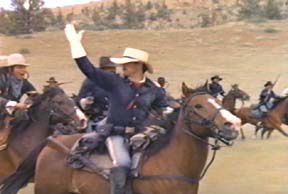
The guns were all tested for defective cartridges, endurance, accuracy, rapidity of fire, firing with excessive charges, and effects of dust and rust. The Springfield was the winner. The Model 1873 carried by the 7th Cavalry was a carbine that weighed 7 pounds and had an overall length of 41 inches. It used a .45-caliber copper-cased cartridge, a 405-grain bullet and a charge of 55 grains of black powder. The best effective range for this carbine was under 300 yards, but significant hits still could be scored out to 600 yards. A bullet was driven out of the muzzle at a velocity of about 1,200 feet per second, with 1,650 foot-pounds of energy. The trapdoor Springfield could hurl a slug more than 1,000 yards and, with proper training, could be fired with accuracy 12 to 15 times per minute.The Colt Single Action Army revolver was chosen over other Colts, Remingtons and Starrs. By 1871, the percussion cap models were being converted for use with metallic cartridges. Ordnance testing in 1874 narrowed the field to two final contenders: the Colt Single Action Army and the Smith & Wesson Schofield.  The Schofield won only in speed of ejecting empty cartridges. The Colt won in firing, sanding and rust trials and had fewer, simpler and stronger parts. The Model 'P' had a barrel of 7.5 inches and fired six .45-caliber metallic cartridges with 28 grains of black powder. It had a muzzle velocity of 810 feet per second, with 400 foot-pounds of energy. Its effective range dropped off rapidly over 60 yards, however. The standard U.S. issue of the period had a blue finish, case-hardened hammer and frame, and walnut grips. The Colt became ubiquitous on the frontier. To the soldier it was a 'thumb-buster,' to the lawman a 'peacemaker' or 'equalizer,' and to the civilian a 'hog leg' or 'plow-handle.' The revolver was so strong and dependable that, with minor modifications, it was still being produced by the Colt Company into the 1980s.
The Schofield won only in speed of ejecting empty cartridges. The Colt won in firing, sanding and rust trials and had fewer, simpler and stronger parts. The Model 'P' had a barrel of 7.5 inches and fired six .45-caliber metallic cartridges with 28 grains of black powder. It had a muzzle velocity of 810 feet per second, with 400 foot-pounds of energy. Its effective range dropped off rapidly over 60 yards, however. The standard U.S. issue of the period had a blue finish, case-hardened hammer and frame, and walnut grips. The Colt became ubiquitous on the frontier. To the soldier it was a 'thumb-buster,' to the lawman a 'peacemaker' or 'equalizer,' and to the civilian a 'hog leg' or 'plow-handle.' The revolver was so strong and dependable that, with minor modifications, it was still being produced by the Colt Company into the 1980s.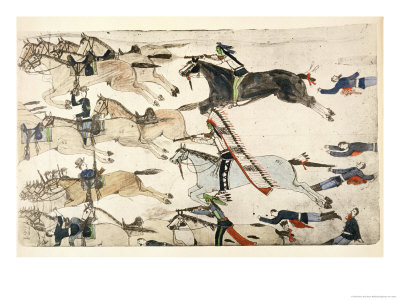
SO WHY DID THE 7TH LOSE THE BATTLE, THEY HAD ENOUGH FIREPOWER TO WIN IT. THE ANSWER LIES MAYBE IN THE FACT THAT THERE WAS NO FINAL STAND AND THE RAW RECRUITS OF THE SEVENTH WHO WERE MALNOURISHED RUN.
SOME HISTORIANS SAY MOST WERE SHOT IN THE BACK OTHERS SAY THEY SIMPLY FAILED TO HOLD THE LINE.What was the truth? At the battle of Ishanwanda they say there was a total eclipse and the Zulu was able to make it into the British lines, others say that single shot rifles were no good. The fact might be that the single shot at long range in the hands of pros was well worth any savage onslaught but in the hands of raw recruits it was no good.
.The original Springfield Rifle adopted by the army was not .45 caliber. It was a .50. Also the ammunition issued for the .45 jammed notoriously and was a factor in the battle, the 1985-85 archaeolgical report at Little Bighorn suggests this. The Jamming of weapons was more prevalent among the Sioux and Cheyenne weapons than it was for U.S. Army Springfields.
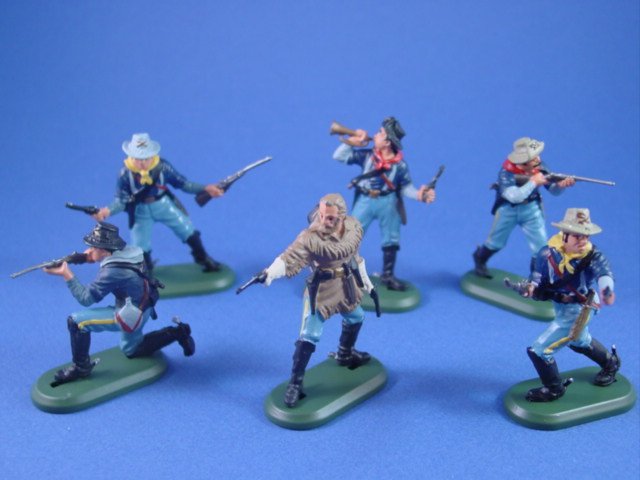
But Crook's 15 cavalry companies expended approximately 80,000 rounds of .45/55 ammunition at the Rosetta on 17 June 1876 but experienced little to no documented jamming.monroe below

Custer was beat in a straight-up engagement. Bested by warriors who fought better than his immediate command. No excuses for his defeat are needed. He lost because the Sioux/Cheyenne won.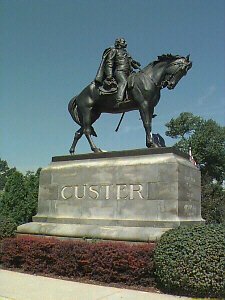
But it seems that Jammed springfiields were prevalent at the Battle of the Little Big Horn. Numerous busted pocket knives found of troopers trying to clear jams. Numerous indian's reported trooper fighting with jammed trapdoors. They also reported throwing many jammed rifles into the river as they were useless.
Perhaps 6 or 7 cases with blown heads. Only a small portion of what had occurred. Right after the battle Army Ordinance changed the ammunition and covered up the incident much like they did with the M16 in Vietnam!
We might say that the LBH was not a stand up fight, and the indian's did not fight better than the soldiers but Custer broke his command into three sections, did not wait for the second half of his detachment, and went glory hunting on his own. Three small units, jamming carbines, hordes of indian's. The results were predictable. This hardly makes great stand-up fighters of the indian's.
There is considerable evidence to suggest the indians lost a far greater number than is accepted by dogma. In fact they may have actually lost thousands. Like always however there has been a cover up at grass roots level by the Michelle Bachmann type mentality.
The explanation for the flow of the battle and command suddenly going from offense to defense after the MTC crossing is that Custer was mortally shot at that point, rather then sitting uphill and watching Yates charge the village (which totally contradicts Custer's charatcter and command expectations of the time of having the Genreal at the head of the command) or sending Yates to reconnoiter the village, which was lightly defended but yet not attacked. My only puzzle with this theory is was Surgeon Lord's body was not found by last stand hill but rather with E/F further down towards the River.(Monroe Above)
It would make sense that he would have stayed close to wounded Custer unless of course Custer was dead and nothing could be done for him. Weapon jamming could explain the sudden onset of despair evident by the seeming widespread evidence of suicide pacts (frequent occurance of two paired 
markers) . But .At the Battle of the Rosebud Gen. Crooks account never mentions any jamming of the Springfield's during extensive ammunition expenditure that I can remember. Your own conclusions can be drawn from this. Crook was primarily saved by his own indian allies.
Custer's immediate command of 210 men was wiped out and more than 250 troopers and scouts were killed in the fighting on June 25-26,it seems that not thousands of indians were killed, the Indians lost 
only about 40 or 50 men according to reliable sources. The explanation appears to lie in the fact that weapons are no better than the men who use them.
Marksmanship training in the frontier Army prior to the 1880s was almost nil. An Army officer recalled the 1870s with nostalgia. 'Those were the good old days,' he said. 'Target practice was practically unknown.' A penurious government allowed only about 20 rounds per year for training–a situation 
altered only because of the Custer disaster. If we are to know the part the Springfield played in the defeat of Custer first we should research the M-16 in Vietnam and how many soldiers got killed with the improper ammunition issued, then they would have some background to understand the part the rifles Custer was armed with in his defeat,.a weapon is more likely to cease on continual, sustained fire, in the last moments of the battle.
The troopers would have had no time to clear blockages and the guns became clubs, perhaps where the talk of troopers holding up their guns has been mentioned, was a misinterpretation of this?The facts are the Springfield jammed after a few shots and was often unusable. The reason for this was the new 45-70 used a soft copper case like the lower pressure, reliable 50-70. After some minimal fouling the case tended to stick in the chamber and the extractor cut through the rim leaving the fouled case in the chamber. This is not opinion! It is substantiated by the Frankfort Arsenal  reports of the time.Sometimes the trooper could dig the case out with a pocket knife, sometimes and eventually he could not. He had no saber to fight with. So the 1873 Colt issued with 25 cartridges
reports of the time.Sometimes the trooper could dig the case out with a pocket knife, sometimes and eventually he could not. He had no saber to fight with. So the 1873 Colt issued with 25 cartridges 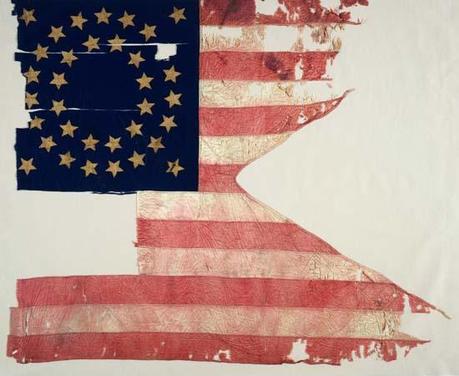 became highly significant. Smart troopers carried more cartridges and another revolver as well. Custer is quoted in the recent movie Son of the Morning Star, "The Springfield jams after a few shots and that's why the officers
became highly significant. Smart troopers carried more cartridges and another revolver as well. Custer is quoted in the recent movie Son of the Morning Star, "The Springfield jams after a few shots and that's why the officers 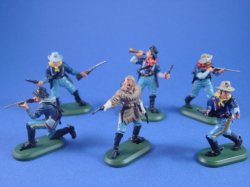 buy their own guns and ammunition." Numerous different revolvers and ammunition have been found at the battle site.Most of this firing was done at close range. The troopers theoretically could have fired
buy their own guns and ammunition." Numerous different revolvers and ammunition have been found at the battle site.Most of this firing was done at close range. The troopers theoretically could have fired  23,000 45-70 rounds at close charging indians, they also could have fired around 6000 revolver 45 Colt cartridges at a close range enemy. Probably much higher for the revolver cartridges and considerably lower for the rifle, more
23,000 45-70 rounds at close charging indians, they also could have fired around 6000 revolver 45 Colt cartridges at a close range enemy. Probably much higher for the revolver cartridges and considerably lower for the rifle, more 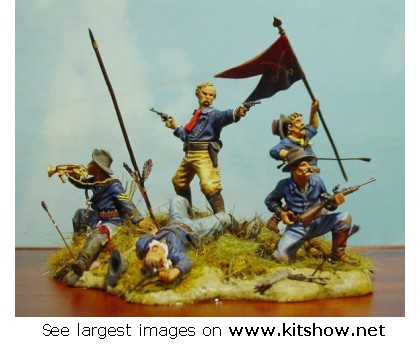 revolvers and ammunition than recorded which may even out. Nearly 30,000 possible rounds fired in this engagement. If 25% solid hits were, that would equal 7500 probable kills or serious wounds.
revolvers and ammunition than recorded which may even out. Nearly 30,000 possible rounds fired in this engagement. If 25% solid hits were, that would equal 7500 probable kills or serious wounds. Could any serious student of linear logic and serious researcher of history believe a fallacious number like only 33 indians were killed in this engagement I leave it to your good logic but it may have happened if Custer was dead and his men running and I read that most of these men had difficulty with English as many were just off immigrant boats.. It is an
Could any serious student of linear logic and serious researcher of history believe a fallacious number like only 33 indians were killed in this engagement I leave it to your good logic but it may have happened if Custer was dead and his men running and I read that most of these men had difficulty with English as many were just off immigrant boats.. It is an  impossibility to think that they ran but maybe its true..
impossibility to think that they ran but maybe its true..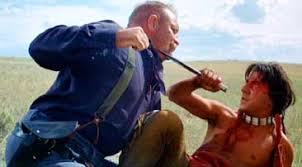
The army lied about the battle because of Custer's incompetent leadership leading his underarmed and split up command to annihilation and the bad ammunition for the rifles. the indians lied because they did not want to admit the horrific losses, and history endorsed it for the clueless! Much of history is bullshit , just look at Gheddafi's defeat in Libya put down to a revolution when evreryone knows it was SAS and Foreign Legion spearheading attacks for the rebels.
So The jamming of the new (check out plastic toy soldiers website some great buys) Springfield .45-70 copper cased cartridges is a matter of historical accuracy.It is a known technological fact despite the army attempting a cover up and changing to the harder brass case immediately after the battle.Custer's men were fighting with single-shot carbines. I don't think there's any doubt from the
Springfield .45-70 copper cased cartridges is a matter of historical accuracy.It is a known technological fact despite the army attempting a cover up and changing to the harder brass case immediately after the battle.Custer's men were fighting with single-shot carbines. I don't think there's any doubt from the 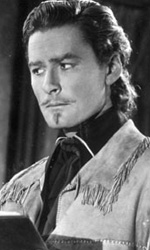 archeological evidence that the 7th Cavalry were outgunned at Little Bighorn. I wouldn't be surprised by a bad ammo problem in light of Ordinance's record.But why were they outgunned, because they were skedadling?
archeological evidence that the 7th Cavalry were outgunned at Little Bighorn. I wouldn't be surprised by a bad ammo problem in light of Ordinance's record.But why were they outgunned, because they were skedadling?
When the Indians came boiling out to fight, Custer's command began to disintegrate and didn't 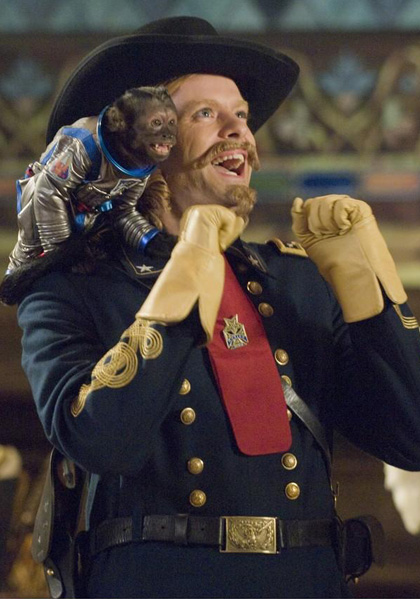 regroup effectively.This suggested from the uneven evidence of heavy defensive fire (including revolvers) that a
regroup effectively.This suggested from the uneven evidence of heavy defensive fire (including revolvers) that a 
good number of the cavalrymen succumbed to panic.But one thing is sure, something happened that  someone knows but doesnt want to put forward as a plan. My thinking is this, Malnourished, raw, and not willing to fight to the last. I make this idea purely as a possibility but I think its a strong one but nevertheless God rest the souls of those killed at the Big Horn.
someone knows but doesnt want to put forward as a plan. My thinking is this, Malnourished, raw, and not willing to fight to the last. I make this idea purely as a possibility but I think its a strong one but nevertheless God rest the souls of those killed at the Big Horn.
Theodore Roosevelt used an engraved, pistol-gripped half-magazine '76 during his early hunting expeditions in the West and praised it. A '76 was also found in the possession of Apache warrior Geronimo after his surrender in 1886.
The Winchester Model 1876 or Centennial Model was a heavier-framed rifle than the Model 1866 or Model 1873, and was the first to be chambered for full-powered centerfire rifle cartridges, as opposed to rimfire cartridges or handgun-sized centerfire rounds.  And while similar in design to the 1873, the 1876 was actually based on the prototype 1868 lever-action rifle that was never commercially produced by Winchester
And while similar in design to the 1873, the 1876 was actually based on the prototype 1868 lever-action rifle that was never commercially produced by Winchester
The Model 1886 continued the trend towards chambering heavier rounds, and had an all-new and considerably stronger locking-block action than the toggle-link Model 1876. It was designed by John Moses Browning,
 who had a long and profitable relationship with Winchester from the 1880s to the early 1900s. In many respects the Model 1886 was a true American express rifle, as it could be chambered in the more powerful black powder cartridges of the day, such as the .45-70 Government (chambering a rifle for the popular .45-70 had been a goal of
who had a long and profitable relationship with Winchester from the 1880s to the early 1900s. In many respects the Model 1886 was a true American express rifle, as it could be chambered in the more powerful black powder cartridges of the day, such as the .45-70 Government (chambering a rifle for the popular .45-70 had been a goal of  Winchester for some time). The 1886 proved capable of handling not merely the .45 Gov't but also the huge .45-90 and .50-110 Express "buffalo" cartridges,and in 1903 was chambered for the smokeless high-velocity .33 WCF. In 1935 Winchester introduced a slightly modified M1886 as the Model 71, chambered for the very powerful .348 Winchester cartridge.
Winchester for some time). The 1886 proved capable of handling not merely the .45 Gov't but also the huge .45-90 and .50-110 Express "buffalo" cartridges,and in 1903 was chambered for the smokeless high-velocity .33 WCF. In 1935 Winchester introduced a slightly modified M1886 as the Model 71, chambered for the very powerful .348 Winchester cartridge.
Winchester Model 1892
It returned to its roots with the Model 1892, which, like the first lever-action guns, was primarily chambered for shorter, lower-pressure handgun rounds. The Model 1892, however, incorporates a much stronger Browning action (based on the larger M1886) than the earlier Henry-derived arms of the 1860s and 1870s. 1,004,675 Model 1892 rifles were made by Winchester, and although the company phased them out in the 1930s, they are still being made under the Puma label by the Brazilian arms maker, Rossi, and by Chiappa Firearms, an Italian factory.
In its modern form, using updated materials and production techniques, the Model 1892's action is strong enough to chamber high pressure handgun rounds, such as .357 Magnum, .44 Magnum, and the high-powered .454 Casull round.
In its modern form, using updated materials and production techniques, the Model 1892's action is strong enough to chamber high pressure handgun rounds, such as .357 Magnum, .44 Magnum, and the high-powered .454 Casull round.
Winchester Model 1894
Main article: Winchester Model 1894

The John Browning designed Winchester Model 1894 is perhaps the best known of the Winchester repeating rifles. The Model 94 was chambered for the newly introduced smokeless .30-30 Winchester cartridge, and later, a variety of calibers such as .25-35 WCF, .32-40 WCF, .32 Winchester Special, and the .38-55. Winchester was the first company to manufacture a civilian rifle chambered for the new smokeless propellants, and although delays prevented the .30-30 cartridge from appearing on the shelves until 1895, it remained the first commercially available smokeless powder round for the North American consumer market.
Though initially it was too expensive for most shooters, the Model 1894 went on to become one of the best-selling hunting rifles of all time—it has the distinction of being the first sporting/hunting rifle to sell over one million units, ultimately selling over seven million until US production was discontinued in 2006. A 2010 commemorative rifle has been produced to celebrate 200 years since Oliver F. Winchester's birth. The Winchester 94/.30-30 combination is practically synonymous with "deer rifle."

The Winchester Model 1895 has the distinction of being the first Winchester lever-action rifle to load from a box magazine instead of a tube under the barrel. This allowed the Model 1895 to be chambered for military cartridges with spitzer (pointed) projectiles, and the rifle was used by the armed forces of a number of nations including the United States, Great Britain, andImperial Russia.
The Russian production models could also be loaded using charger clips, a feature not found on any other lever-action rifle. Calibers included .30-40 Krag (.30 US or .30 Army), .303 British, .30-03 Springfield, .30-06 Springfield, 7.62mm Russian, and the mighty .405 Winchester. Teddy Roosevelt used a Model 1895 in .405 on African safari, and called it his "Big Medicine" for lions.[9] In 1908 the 1895 Winchester became the first commercially produced sporting rifle chambered in .30-06 (then called ".30 Gov't 06").
The Russian production models could also be loaded using charger clips, a feature not found on any other lever-action rifle. Calibers included .30-40 Krag (.30 US or .30 Army), .303 British, .30-03 Springfield, .30-06 Springfield, 7.62mm Russian, and the mighty .405 Winchester. Teddy Roosevelt used a Model 1895 in .405 on African safari, and called it his "Big Medicine" for lions.[9] In 1908 the 1895 Winchester became the first commercially produced sporting rifle chambered in .30-06 (then called ".30 Gov't 06").
]Winchester Model 88
Introduced in 1955, sixty years after Winchester's last all-new lever-action design, the Model 88 was unlike any previous lever action; it was really a lever-bolt hybrid. A short-throw underlever operated a three-lug rotating bolt, and rounds were fed vertically from a detachable box magazine. These bolt-action features in a "lever-action" permitted the use of high-powered modern short-case cartridges with spitzer bullets: .243, .284, .308 (7.62mm NATO) and .358 Winchester. The 88 did not prove to be especially popular, although it has its share of devoted enthusiasts, and was discontinued in 1973. It is, however the third biggest selling lever action rifle in Winchester's storied history, following only the M1894 (1st) and M1892 (2nd). The later Sako Finnwolf and Browning BLR have similar actions. A Winchester Model 88 in .308 Caliber was used to harvest the current World's Record Typical Whitetail Deer.
Winchester's Model 9422 was introduced in 1972 and was rapidly recognized for high quality. It was designed to capture the image of the traditional lever-actions with exposed hammer, straight grip, tube magazine and barrel bands. Unlike older Winchester lever actions it came grooved for scope mounting. It was offered in .22 Long Rifle and .22 WRM, and was priced at the high-quality end of the .22 sporting rifle market.
The 9422 action design was original and extremely reliable. The feed system handled the cartridge from the magazine to the breech face by its rim, and the slide cammed the rear of the breechblock up into the locking recess. A concealed polymer buffer above the breech gave a firm-feeling lockup and a very positive unlocking motion.

The 9422 had worldwide appeal to customers raised on 'westerns' and to those looking for a fun and historic way to introduce their children to shooting. Over the course of production a higher finished model called the 9422 XTR, a .17 rimfire model, and several commemorative models were offered. Production ended in 2005.
Winchester Model 1885 Single Shot Rifle
Main article: Winchester Model 1885 Single Shot Rifle
In 1885 Winchester entered the single-shot market with the Model 1885 rifle, which John Browning had designed in 1878 (the beginning of the fruitful 20-year Winchester-Browning collaboration). The Winchester Single Shot, known to most shooters as either the "Low-wall" or "High-wall" depending on model, but officially marketed by Winchester as the Single Shot Rifle, was produced to satisfy the demands of the growing sport of "Match Shooting", excelling at it, with Major Ned H. Roberts (inventor of the .257 Roberts cartridge) describing the Model 1885 Single Shot as "...the most reliable, strongest, and altogether best single shot rifle ever produced."[11] Winchester produced nearly 140,000 Single Shot rifles from 1885 to 1920, and it was found that the falling-block Model 1885 had been built with one of the strongest actions known at that time. Winchester also produced a large number of Single Shots in .22 Short for the US Army as a marksmanship training rifle, the "Winder musket."
Winchester lever action rifles remained the most popular in the US through WWI and the interwar period. However, advances in the development of bolt action rifles made them increasingly preferred over lever actions.
These new rifles, such as the Mauser Gewehr 98 and M1903 Springfield, could chamber pointed "Spitzer" bullets, which lever action rifles withtube magazines could not (a pointed bullet can accidentally fire the round in front of it in a tube magazine). Bolt actions as developed by Mauser and other military manufacturers had front locking lugs which stabilized the cartridge head very well, and allowed for unprecedented accuracy. Bolt actions were simpler and cheaper to manufacture than high-power leverguns like Winchester's 1886 and 1895 models.
These new rifles, such as the Mauser Gewehr 98 and M1903 Springfield, could chamber pointed "Spitzer" bullets, which lever action rifles withtube magazines could not (a pointed bullet can accidentally fire the round in front of it in a tube magazine). Bolt actions as developed by Mauser and other military manufacturers had front locking lugs which stabilized the cartridge head very well, and allowed for unprecedented accuracy. Bolt actions were simpler and cheaper to manufacture than high-power leverguns like Winchester's 1886 and 1895 models.

Above Belgian Spencer
The Spencer Repeating rifles and carbines were popular with French and belgian Troops , during 1870-71 Franco-Prussian War many were used. When Spencer stopped making firearms in 1868 and these repeaters were a combination of left over stock and U.S. government surplus that was purchased at auction. Shipping records show that thousands of Spencer firearms and millions of rounds of ammunition were shipped to Europe.
The Spencer was so popular that the private manufacturer Falisse & Trappman of Liege, Belgium manufactured copies in 1873. The company produced less than 1,000 carbines in 1873 and very few a known to have made it back to the U.S. It is unknown whether the carbines were produced for military use or private sales. This is one such Belgium made copy and features a fixed front and folding ladder rear sights, saddle ring and bar on the left side of the stock wrist and is mounted with a smooth forearm secured by a single barrel band and straight grip stock with a sling swivel. The left rear side of the barrel is marked with Liege proof and the left side of the receiver is marked with a "crown/circled A" proofmark, the saddle ring bar plate with a "crown/circled "B" and the right side of the stock with a "crown/circled "I". The top of the receiver is marked "UNION ARMORIERE BELGE / LIEGE". The left side of the upper and lower breech block are correctly marked with the matching serial number, (receivers on these Belgium copies were not numbered). The right side of the stock is stamped with the makers double circle mark "FALISSE & TRAPPMAN / LIEGE" and "1873" in the center. The forearm directly ahead of the receiver is stamped "121" and the barrel band is marked "2272".
BBL: 20 inch round Stock: walnut
Gauge: 50
Finish: blue
Grips:
Serial Number: 2272
 In response to the increasing competition from these bolt-action rifles, Winchester introduced the Winchester Model 54 in 1925. This was not Winchester's first bolt rifle (that distinction belonged to the Winchester-Hotchkiss rifle of 1878), but it was by far their most successful. It was based on the Mauser Gewehr 98 design, but with modifications and popular North American chamberings such as .30-06 which made it more appealing to American hunters than were the European imports or sporterised military rifles. The famed Model 70 was developed from the Model 54, which it replaced in 1936. The Model 70, often dubbed the "rifleman's rifle,"[12] was produced continuously at New Haven (except during WWII) until 2006, and production has resumed at FN Herstal's plant in Columbia, South Carolina.
In response to the increasing competition from these bolt-action rifles, Winchester introduced the Winchester Model 54 in 1925. This was not Winchester's first bolt rifle (that distinction belonged to the Winchester-Hotchkiss rifle of 1878), but it was by far their most successful. It was based on the Mauser Gewehr 98 design, but with modifications and popular North American chamberings such as .30-06 which made it more appealing to American hunters than were the European imports or sporterised military rifles. The famed Model 70 was developed from the Model 54, which it replaced in 1936. The Model 70, often dubbed the "rifleman's rifle,"[12] was produced continuously at New Haven (except during WWII) until 2006, and production has resumed at FN Herstal's plant in Columbia, South Carolina.
The Spencer Repeating rifles and carbines were popular with French and belgian Troops , during 1870-71 Franco-Prussian War many were used. When Spencer stopped making firearms in 1868 and these repeaters were a combination of left over stock and U.S. government surplus that was purchased at auction. Shipping records show that thousands of Spencer firearms and millions of rounds of ammunition were shipped to Europe.
The Spencer was so popular that the private manufacturer Falisse & Trappman of Liege, Belgium manufactured copies in 1873. The company produced less than 1,000 carbines in 1873 and very few a known to have made it back to the U.S. It is unknown whether the carbines were produced for military use or private sales. This is one such Belgium made copy and features a fixed front and folding ladder rear sights, saddle ring and bar on the left side of the stock wrist and is mounted with a smooth forearm secured by a single barrel band and straight grip stock with a sling swivel. The left rear side of the barrel is marked with Liege proof and the left side of the receiver is marked with a "crown/circled A" proofmark, the saddle ring bar plate with a "crown/circled "B" and the right side of the stock with a "crown/circled "I". The top of the receiver is marked "UNION ARMORIERE BELGE / LIEGE". The left side of the upper and lower breech block are correctly marked with the matching serial number, (receivers on these Belgium copies were not numbered). The right side of the stock is stamped with the makers double circle mark "FALISSE & TRAPPMAN / LIEGE" and "1873" in the center. The forearm directly ahead of the receiver is stamped "121" and the barrel band is marked "2272".
BBL: 20 inch round Stock: walnut
Gauge: 50
Finish: blue
Grips:
Serial Number: 2272
 In response to the increasing competition from these bolt-action rifles, Winchester introduced the Winchester Model 54 in 1925. This was not Winchester's first bolt rifle (that distinction belonged to the Winchester-Hotchkiss rifle of 1878), but it was by far their most successful. It was based on the Mauser Gewehr 98 design, but with modifications and popular North American chamberings such as .30-06 which made it more appealing to American hunters than were the European imports or sporterised military rifles. The famed Model 70 was developed from the Model 54, which it replaced in 1936. The Model 70, often dubbed the "rifleman's rifle,"[12] was produced continuously at New Haven (except during WWII) until 2006, and production has resumed at FN Herstal's plant in Columbia, South Carolina.
In response to the increasing competition from these bolt-action rifles, Winchester introduced the Winchester Model 54 in 1925. This was not Winchester's first bolt rifle (that distinction belonged to the Winchester-Hotchkiss rifle of 1878), but it was by far their most successful. It was based on the Mauser Gewehr 98 design, but with modifications and popular North American chamberings such as .30-06 which made it more appealing to American hunters than were the European imports or sporterised military rifles. The famed Model 70 was developed from the Model 54, which it replaced in 1936. The Model 70, often dubbed the "rifleman's rifle,"[12] was produced continuously at New Haven (except during WWII) until 2006, and production has resumed at FN Herstal's plant in Columbia, South Carolina.From 1900 Winchester manufactured cheap single shot .22 bolt action rifles, including the models 1900, 1902, 1904 and 99. On the other hand, in 1920 Winchester introduced the high-quality Model 52 .22 bolt action target rifle, which from its inception and for years thereafter was America's reference standard smallbore match rifle. A very desirable sporter model of this action was also made from 1934-
Winchester Models 1903 and 63
The Winchester Model 1903 was the first commercially available self-loading .22 rimfire caliber in the US. Designed by T.C. Johnson, the Model 1903 was chambered for the unique .22 Winchester Automatic cartridge. In 1919, the Model 1903 moniker was shortened to Model 03, and following a partial redesign in the 1930s, was renamed the Model 63. The Model 63, introduced in 1933, was chambered for the popular and widely available .22 Long Rifle cartridge. It was initially made with a 20" barrel, then with a 23" barrel from 1936 until the end of production in 1958. About 175,000 Model 63 rifles were manufactured, with the last 10,000 having grooved receiver tops for scope mounting. Both the 1903/03 and the 63 have tubular magazines in the butt stock of the rifle and are loaded through a slot in the right side of the butt stock.
The early center fire Winchester self-loading series of rifles began with the Model 1905, chambered for the .32SL and .35SL cartridges. Following a demand for a higher-powered self-loading rifle, the Models 1907 and 1910 were introduced along with their respective cartridges, the .351SL and .401SL.
The Winchester Model 1887 was the first successful repeating shotgun design, developed by John Browning and produced by Winchester from 1887-1920. Browning felt that a pump-action would be much more appropriate for a repeating shotgun, but as Winchester was primarily a lever-action firearms company they felt that their new shotgun must also be a lever-action for reasons of brand recognition. The M1887 was chambered for 12ga black powder shotshells, and after the switch to smokeless powder at the end of the 19th Century, the M1901 was introduced, being chambered for 10ga smokeless shells. Although a technically sound gun design, the market for lever-action shotguns waned considerably after the introduction of the Winchester 1897 and other contemporary pump-action shotguns; modern reproductions of the gun have been manufactured by Norinco in China, ADI Ltd. in Australia and Chiappa Firearms in Italy.

Another Browning design, the Winchester Model 1893 (and later Model 1897) was one of the first successful pump-action shotgun designs, being introduced in 1893 and remaining in production until the mid 1950s. Unusual for a repeating shotgun, the Model 1897 could be taken apart for easier carriage/storage, and was available in a variety of barrel lengths from 20in to 36in. During World War I it was issued as a trench gun, with short barrel, heat shield and M1917 bayonet.]

Winchester Model 1911
Ma

Winchester's long association with John Browning came to an end acrimoniously when the company refused to accept Browning's terms for the right to manufacture his revolutionary 1898 design for a self-loading shotgun; the landmark Browning Auto-5 was produced instead by Fabrique Nationale in Europe and later by Remington Arms in the US. However, Browning's semi-automatic patents had been so tightly drafted by Winchester's own lawyers that it took years for T. C. Johnson to develop a self-loading shotgun which didn't infringe them; this was the Model 1911 SL. The 1911 unfortunately was a flawed and potentially dangerous design, and was not a commercial success; it was dropped in 1925.
Winchester Model 1912
Designed by T.C. Johnson as a hammerless modification of the Model 1897, the Model 1912 (later re dubbed the Model 12) was one of the most successful pump shotguns ever made,  with nearly 2 million produced before its cancellation in 1963. Like the Model 1897 it came in take-down form, and likewise was issued in trench gun and combat versions during both World Wars, Korea and Vietnam.
with nearly 2 million produced before its cancellation in 1963. Like the Model 1897 it came in take-down form, and likewise was issued in trench gun and combat versions during both World Wars, Korea and Vietnam.

 with nearly 2 million produced before its cancellation in 1963. Like the Model 1897 it came in take-down form, and likewise was issued in trench gun and combat versions during both World Wars, Korea and Vietnam.
with nearly 2 million produced before its cancellation in 1963. Like the Model 1897 it came in take-down form, and likewise was issued in trench gun and combat versions during both World Wars, Korea and Vietnam.

The members of the "Wild Bunch", most notably Pike Bishop, Dutch Engstrom, Lyle Gorch, and Angel, use Colt M1911 pistols. As with many other films made during this time, 9 mm Star Model B pistols were used instead as they were more reliable with blanks.After shooting Gen. Mapache, Pike spins around with his M1911 and Winchester '97 in hand. The German government official with Gen. Mapache notes that the "Wild Bunch" are carrying them, noting to tell them that they cannot be acquired legallyby private citizens. In the film, you can see that they use both M1911's and Star Model B's as well, the pictures from the film below you can tell the difference from a M1911A1 to Star model b, just by looking at the diameter of barrel and size. The Model 12 was popular with the military, law enforcement, hunters, and sporting clay competitors, the latter regarding it as having superior balance and "point" among pump-actions.
The Model 12 was popular with the military, law enforcement, hunters, and sporting clay competitors, the latter regarding it as having superior balance and "point" among pump-actions.
 The Model 12 was popular with the military, law enforcement, hunters, and sporting clay competitors, the latter regarding it as having superior balance and "point" among pump-actions.
The Model 12 was popular with the military, law enforcement, hunters, and sporting clay competitors, the latter regarding it as having superior balance and "point" among pump-actions.
A Mexican soldier holds his own New Service and Dutch's SAA after Angel shoots his ex-fiancee Teresa.


Winchester used to advertise that the Model 1873 levergun won the West, which actually didn't see wide distribution until a couple of years later. Disputing the claim, Sharps shooters long ago coined the comeback, "Sharps made the West safe for Winchesters."

The invention of the Colt seems to have been the turning point of making the west safe from real Americans.
Revolvers and handguns in general aren't used to conquer territory, they are last-ditch personal defense weapons but the Texas rangers used them as assualt arms. .
Once, someplace I can't remember, someone wrote the double barreled shotgun won the West.
With it, settlers foraged for food, rabbits, birds and whatnot, to feed their families while they tilled the soil.
That sounds good, too, sort of a little house on the prairie kind of thing. It just doesn't wash. If the Cheyenne, Kiowa, Comanche or others were active, Mr. Tiller-of-the-fields wouldn't have made it far from the cabin with his old double barrel. And if the buffalo herds had been intact, his fields would have been pounded to dust by their passing.
So which guns did win the West? flintlock muzzleloading military rifles on their long, long trip all the way to the West coast and back didn't win anything, too slow for Indians and not even as fast as the arrow.This idea brings into consideration of why the Elizabethans gave up the bow for very slow loading muskets.
It's my considered opinion the "guns that won the West" were two basic types--Military rifles and carbines, as well as hunting rifles. This was most especially true after such rifles and carbines became chambered for metallic cartridges, there's an 800-page book titled Texas Indian Fighters by A.J. Sowell. It was written about 1890 and consists of interviews done with elderly Texans concerning their adventures in taming Texas.

Some of it went all the way back to the Alamo fracas of 1836. In very many of the stories, the Comanche Indians were armed with bows and arrows and lances with perhaps a few single-shot muzzleloaders thrown in.
On the other side, the Texas settlers had a few revolvers and muzzleloading long guns, both rifles and shotguns. When the odds were like that, sometimes the settlers won the fight, sometimes the Comanche did, and sometimes it was a tie.
However, as time passed and the Texans began to have metallic cartridge firing repeating rifles such as the Henry and Winchester Model 1866 firing the rimfire .44 Henry, things began to change. Overwhelmingly then the Texans won.

Another fight with Indians in which metallic cartridges figured prominently was the Wagon Box Fight near Fort Phil Kearny (near present day Story, Wyoming) in August of 1867.

What the Indians didn't know was shortly prior to this the soldiers had received their new Model 1866 "Trapdoor" Springfields firing .50-70 metallic cartridges, which actually were conversions of those previous muzzleloading muskets.
 Instead of ramming a paper cartridge down the barrels of their rifle-muskets, all the soldiers had to do was flip open the "trapdoor" breechblock, drop in a .50-70, snap the breechblock shut, cock the hammer and fire.
Instead of ramming a paper cartridge down the barrels of their rifle-muskets, all the soldiers had to do was flip open the "trapdoor" breechblock, drop in a .50-70, snap the breechblock shut, cock the hammer and fire.
Crescent first world war British can be used as Mexicans if painted up properly
It's not hard for someone to fire a dozen shots in a minute with a Trapdoor as opposed to perhaps two a minute with a rifle-musket.

And so, after the Sioux warriors "soaked up" the first volley from inside the wagon boxes, they were hit with another and another every few seconds. It was a resounding defeat for them. The US Army stuck with .50-70 trapdoors through the Model 1868 and Model 1870, and didn't give them up until the .45-70 trapdoors appeared with the Model 1873.
Hand "Em Out

Also, with all those obsolete .50-70 trapdoors and their ammunition setting around, the government was pretty free with handing them out. As late as 1876 the Arickara and Crow Indian scouts hired by the 7th
 Cavalry to accompany that ill-fated 1876 expedition were issued .50-70 trapdoors.
Cavalry to accompany that ill-fated 1876 expedition were issued .50-70 trapdoors. And a civilian expedition searching for gold in eastern Montana in 1874 were carrying .50-70 trapdoors handed out by the territorial governor.
And a civilian expedition searching for gold in eastern Montana in 1874 were carrying .50-70 trapdoors handed out by the territorial governor.
So my first vote goes to any military rifle or carbine chambered for the .50-70 Government cartridge.
 Why did I say "any military rifle or carbine chambered for the .50-70" and not just Trapdoor .50-70s? Because the US Government didn't get around to producing a Trapdoor carbine .50-70 until the Model 1870. Prior to that they sent back tens of thousands of Sharps Model 1859,
Why did I say "any military rifle or carbine chambered for the .50-70" and not just Trapdoor .50-70s? Because the US Government didn't get around to producing a Trapdoor carbine .50-70 until the Model 1870. Prior to that they sent back tens of thousands of Sharps Model 1859, 1863, and 1865 percussion carbines to their manufacturer and had them converted to .50-70. (By the way all three of those models were virtually identical except for their model number stamping.)
1863, and 1865 percussion carbines to their manufacturer and had them converted to .50-70. (By the way all three of those models were virtually identical except for their model number stamping.)Anyway, the government did something rather odd with these Sharps carbines in the conversion process. Since they had originally been made with .52, 53, and .54 caliber barrels, the government instructed the Sharps factory to bore out the barrels and line them with 3-groove liners if their barrels measured
 over .5225". Under that measurement and they were left with their original 6-groove barrels.
over .5225". Under that measurement and they were left with their original 6-groove barrels.
That makes identifying the different ones as easy as casually looking down the bore. A great many of these Sharps .50-70 carbine conversions were never issued, but some did see action in the West. In fact, several companies of Custer's 7th Cavalry stationed in the Dakotas turned in such carbines circa 1874 when the first issues of the brand new Model 1873 .45-70 Trapdoor carbines came along.

By the way the plastic soldiers above are cherilea not crescent but if you get the mounties they can easily be the Wild Bunch painted up in the right colours

Another reason I wouldn't just limit the .50-70 to Trapdoors in my pick of guns that won the West, is it was also a popular chambering in both Remington and Sharps single-shot rifles starting in the late 1860s. Remington offered it in both their military-style Rolling Blocks and their sporting rifles. In fact, the US Army and Navy both bought quantities of .50-70 Rolling Blocks for limited use.
 And there's a variation of Sharps rifles called the Springfield/Sharps by collectors, wherein the Sharps factory produced musket-style variations fitted with Springfield Armory-made barrels. About 300 of these .50-70s were made for field-testing in the West, but the Army declined to convert from Trapdoors to them.
And there's a variation of Sharps rifles called the Springfield/Sharps by collectors, wherein the Sharps factory produced musket-style variations fitted with Springfield Armory-made barrels. About 300 of these .50-70s were made for field-testing in the West, but the Army declined to convert from Trapdoors to them.
|



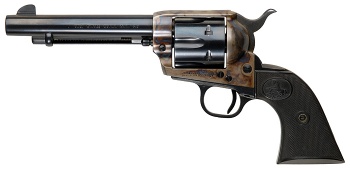
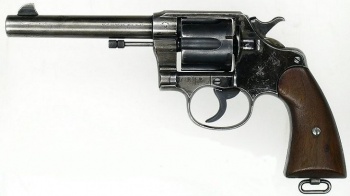
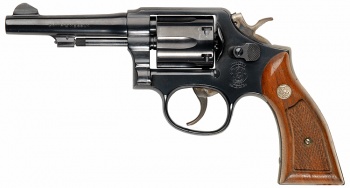
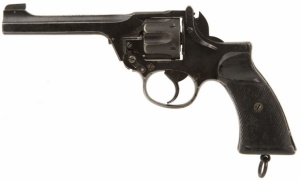
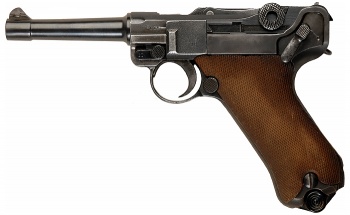
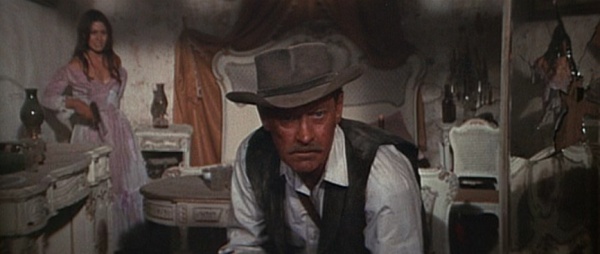

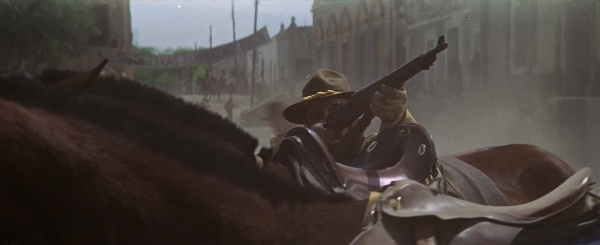
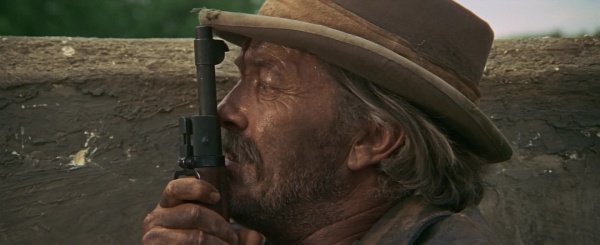
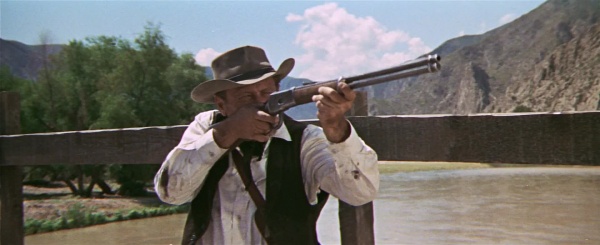
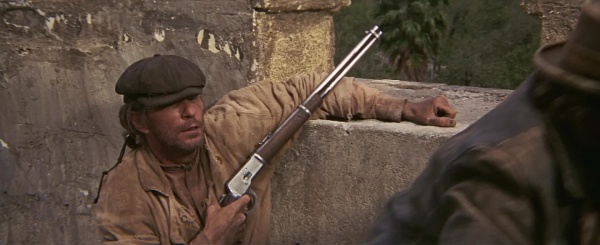


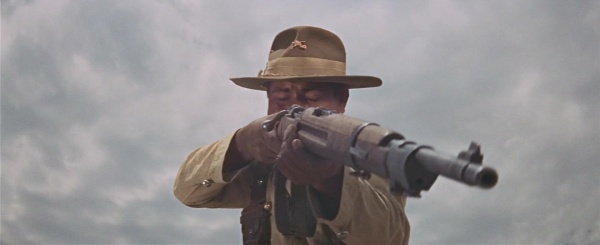


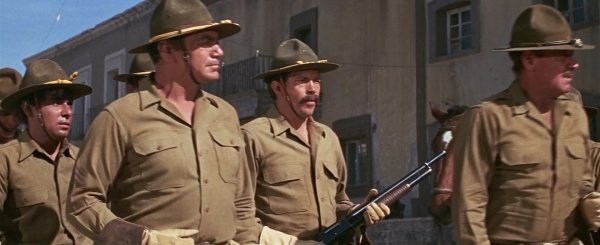


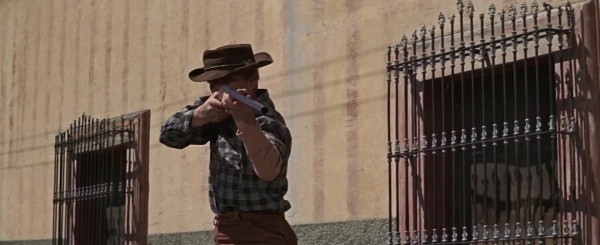

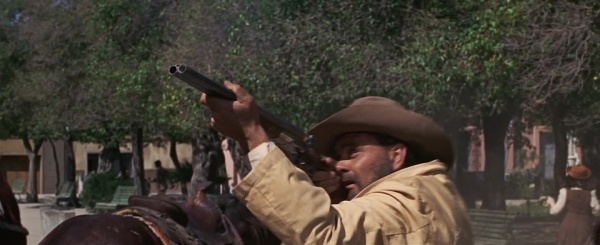
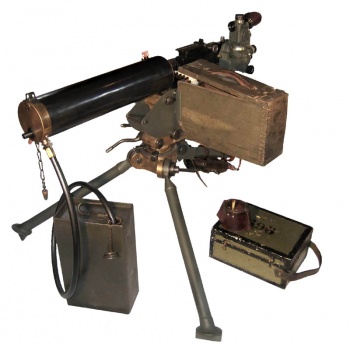
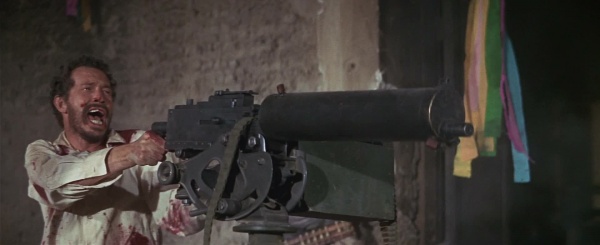
No comments:
Post a Comment